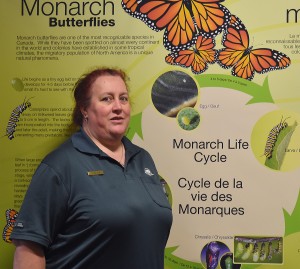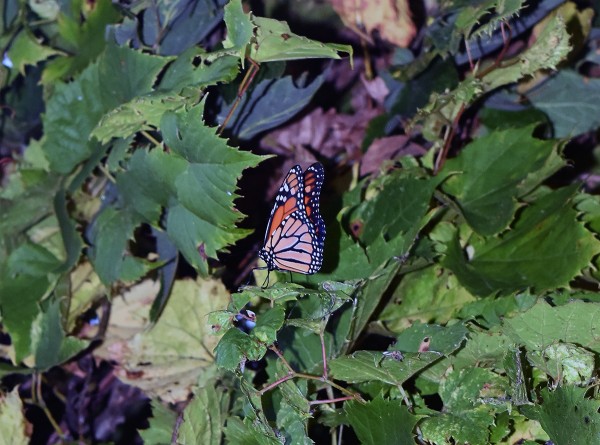A unique natural phenomena

Sarah Rupert is the promotion officer at Point Pelee National Park in Leamington, ON. (Photo by Alyssa Leonard).
By Alyssa Leonard
A few weeks each spring and fall, people come from all over the world to see the monarch butterfly pass through Point Pelee National Park during its annual migration.
The monarch migration across North America is a unique phenomenon that has been happening for centuries, yet it was not until 1975 when biologist Fred Urquhart at the University of Toronto began tagging monarch butterflies to determine where they were migrating to each year.
Monarchs travel as far north as Ottawa and Quebec for the eastern migration in the spring and return to Mexico for the winter where they stay in an almost hibernate-like state until the warmer weather returns.
In the summertime, two to three generations will be raised in Ontario. The generation born closest to fall is somehow triggered to migrate instead of mate. How this trigger is implemented remains a mystery.
Sarah Rupert, promotion officer at Point Pelee National Park, said people have travelled from all over the world to marvel at the migration, going as far as scheduling holidays and vacations around migration times or even taking spontaneous trips after work. She said many people come from Europe every year to see the migration, as well as from across Ontario, Michigan and Ohio. This year, people came from as far as Australia. Rupert said they have seen a big increase in the number of people from the Greater Toronto Area coming to the park this year.
Butterflyway Ranger Laura Hendrickson is a Toronto community volunteer with the David Suzuki Foundation’s Butterflyway Project, where they recruit community volunteers to plant networks of native wildflowers in yards, schools, streets and parks. She said she did not know the monarchs came to Point Pelee National Park until she discovered the migration while exploring with some students. She drove down from Toronto to see them.
“It’s an amazing place,” said Hendrickson about the park. “We came here hoping to see one of the big clusters [of monarchs].”
Monarchs will wait for the temperature to rise above 10 degrees Celsius before taking flight. According to Rupert, the time to see the monarchs is between late August and the middle of October. Once the temperature drops below 10 degrees Celsius it becomes too cold for them to fly.
Practice manager at Preventive Care Center in Flint, MI is not Elly McCue’s only day job. She has been raising monarchs in her yard for about two years, even removing 65 rose bushes to replace them with native wildflowers flowers and milkweed plants.
“I look for the eggs and I bring them in and raise them in a little pop-up,” said McCue. “Monarchs to me are most magical because of the migration.”

A monarch butterfly taking a rest on some vines at Point Pelee National Park. Photo by Alyssa Leonard.
McCue said she has been following the Pelee Paradise Sanctuary Monarch Waystation, Point Pelee National Park and the Monarchs Migrating Through Ontario Facebook pages to track the monarchs’ migration path. She said she had also made the two hour trip to Point Pelee a couple of weeks ago to see them, but with no luck.
Rupert said the probability of seeing monarchs depends on the weather. She said there have been times when the same group of monarchs have been stuck at the park for 10 days because of bad weather and strong winds. However, if the weather is warm with no wind, monarchs will fly right over the lake instead of resting at Point Pelee.
“They will ride on thermals, they just kind of glide on them,” said Rupert. “That really nice stretch of really warm weather [in September], they didn’t stop. So people were just seeing them migrate right off the tip.”
She said monarch migration has been a part of the park’s history for a really long time. They have been written about in old journals from people studying bird migrations and older residents of the area talk about the monarchs.
“Because of our peninsula, because monarchs follow the shorelines when they’re migrating, they get funneled down to the tip,” said Rupert. “Migration is really one of the reasons this park is so important to so many species. We’re a transient home to a lot of little creatures.”


